1710 Hall: The Rose Room/The Empire Room/The Ascot Room — 1942-1975
by Paula Bosse
by Paula Bosse
The photo above was taken at the Rose Ballroom at 1710 Hall Street (a few steps off Ross Avenue) in August, 1942. 1710 Hall was the home to a string of very popular black nightclubs: the Rose Ballroom (1942-1943), the Rose Room (1943-1951), the Empire Room (1951-1969) (not to be confused with the nightclub of the same name in the Statler Hilton), and the Ascot Room (1969-1975). There seems to have been some overlap of owners and/or managers and/or booking agents, but they all appear to have been very popular “joints” (as described by Freddie King’s daughter), where both big-name touring musicians as well as popular local acts played. Icons T-Bone Walker and Ray Charles were regulars (there are stories of Ray Charles sleeping on the Empire Room’s stage during the time he was living in Dallas in the ’50s). Everybody seems to have played there. Below, a quote from Wanda King, talking about her father, blues legend Freddie King — from the book Texas Blues: The Rise of a Contemporary Sound by Alan Govenar (all clippings and photos are larger when clicked):
Some of the acts scheduled to appear in early 1946 at the Rose Room were Erskine Hawkins, Louis Armstrong, Lionel Hampton, Buddy Johnson, and Andy Kirk. …Wow.
In the days of segregation, when Dallas police threatened to shut the club down if the owner allowed white patrons to mix with black patrons, the club scheduled “white only” nights where Caucasian audiences could see their favorite non-Caucasian performers. (Before these special club nights, which seem to have started in 1945, a revue would be taken “on the road” — over to the Majestic Theatre on Elm Street — to perform live onstage.)
The photo up there at the top showed the audience — here’s the stage (1946 photo of the E F Band by Marion Butts, from the Marion Butts Collection, Dallas Pubic Library):
And here’s what the stage looked like when the club became the Empire Room (onstage is Joe Johnson in a 1954 photo by R. C. Hickman, taken from a great article about Hickman in Texas Highways, here):
One thing that probably helped set the Rose Room/Empire Room apart from a lot of the other clubs in town at this time was the man who booked the shows — and who booked acts all over the area: John Henry Branch. The guy knew everyone. Here he is in an ad from 1947:
Aside from booking acts and musicians for black clubs, he also booked acts for white clubs — including Jack Ruby’s Carousel and Vegas clubs. In fact, Branch chatted with Ruby at the Empire Room the night before Ruby shot Oswald — Ruby had come in to check on a piano player Branch was booking for a gig at the Vegas Club in Oak Lawn. Branch supplied testimony to the Warren Report, and while it’s not all that riveting (because there wasn’t that much to tell), it’s still interesting to hear how Branch describes his own club and Ruby’s personality (“You can’t never tell about him — he’s a weird person.”) — you can read his testimony here.
I have to admit, I’d never heard of the Rose Room or the Empire Room before I saw the photo at the top of this post. I really missed out. So much fantastic music! And I missed it. It’s just another reminder that Dallas has an incredible music history.
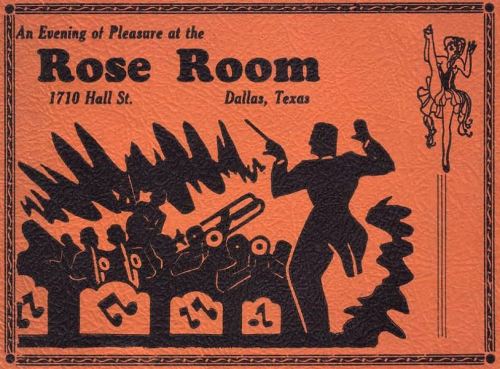 from the Texas African American Photography Archive
from the Texas African American Photography Archive

1700 block of Hall Street, 1944-45 city directory
What’s at 1710 Hall these days? A vacant lot — soon to be developed, no doubt. Ross Avenue ain’t what it used to be….
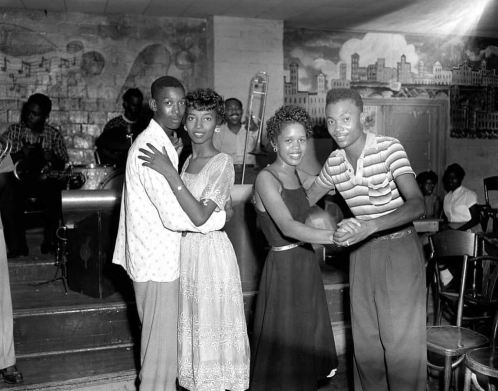 Teen dance, Aug. 6, 1956 (photo by R. C. Hickman)
Teen dance, Aug. 6, 1956 (photo by R. C. Hickman)
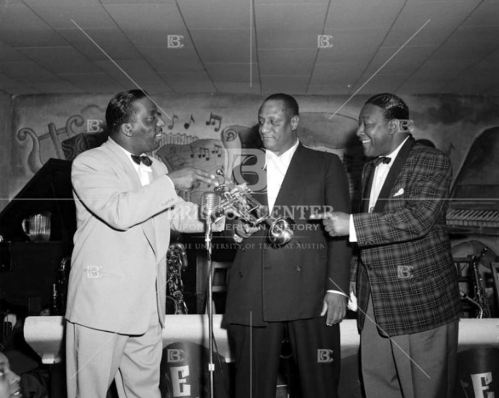 Apr. 23, 1951 (photo by R. C. Hickman, Briscoe Center, Univ. of TX)
Apr. 23, 1951 (photo by R. C. Hickman, Briscoe Center, Univ. of TX)
**
UPDATE: After many fruitless attempts to find a photo of the exterior of this building, I stumbled across it in a 1973 filmed report from KERA, recently uploaded by the G. William Jones Film and Video Collection at SMU. Below is a screenshot showing the Ascot Room a couple of years before it finally closed, looking a little worse for wear. The 8-minute film (which you can watch here) shows tons of locations in the Black neighborhoods of South Dallas (along Forest Avenue/MLK Blvd.) and “North Dallas” (along Hall Street) — the Ascot Room can be seen briefly at the 1:46 mark. (More on this film can be found in the Flashback Dallas post “Black Dallas — 1973.”)
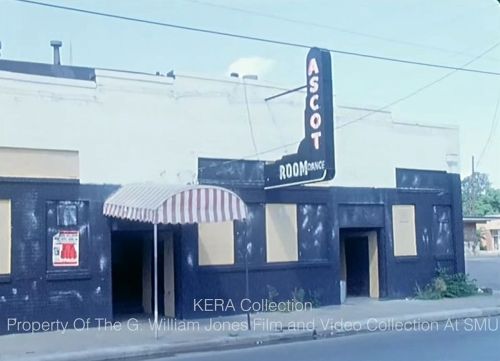 Ascot Room, 1973 (screenshot, Jones Collection, SMU)
Ascot Room, 1973 (screenshot, Jones Collection, SMU)
***
Sources & Notes
Top photo from the George W. Cook Dallas/Texas Image Collection, DeGolyer Library, Central University Libraries, Southern Methodist University; more info on this photo is here. Someone has written this on the photo: “Aug. 42, Dallas, Rose Room” — in August, 1942 the club was known as the Rose Ballroom; it changed its name to the Rose Room in early 1943.
1973 screenshot is from a 1973 film (my guess is that it was broadcast on Channel 13’s “Newsroom”) from the KERA Collection, G. William Jones Film and Video Collection, Hamon Arts Library, Southern Methodist University.
Wanda King quote is from the book Texas Blues: The Rise of a Contemporary Sound by Alan Govenar (College Station: Texas A & M University Press, 2008).
Rose Room ad featuring John Henry Branch is from the 1947-48 Dallas Negro City Directory (with thanks to Pat Lawrence!).
More about the hopping Hall Street area can be found in the Flashback Dallas post “Life on Hall Street — 1947,” here.
*
Copyright © 2017 Paula Bosse. All Rights Reserved.



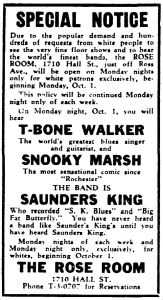
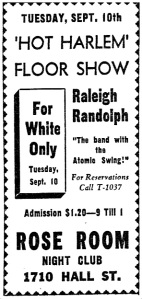

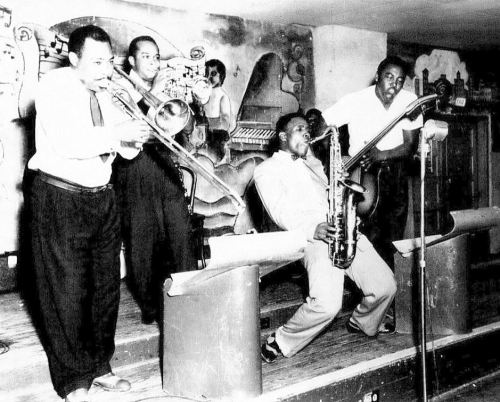

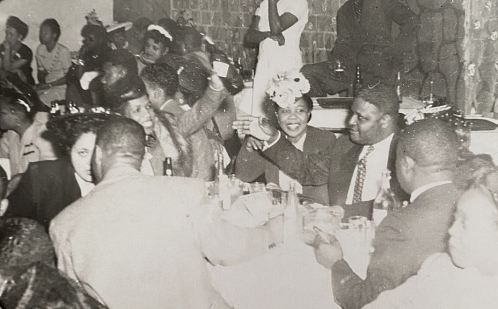
Thank you, Paula. So very interesting! I never knew about the Rooms either, but in 1955 Joe Johnson played regularly at Birch’s/Three to Twelve club on Lemmon, the first place my husband took me on a date. Ray Charles, Fats Domino, etc. would perform at the Plantation on Cadiz at Industrial. Usher ropes about two feet high segregated the blacks and whites. To see those legends up close is one of my favorite memories. As a sidenote, Wanda King and her brother played against my son’s 6th grade band at Fair Park in 1968. Of course Freddie King’s kids won. Our boys didn’t stand a chance. I ran into Wanda at the House of Blues several years ago and she remembered the night well. I was glad to see she stayed in the business. My son did, too, but in the Seattle area, known as Bobby G.
LikeLiked by 1 person
Thanks for the additional info, Joyce! I think the club scene in Dallas in the 1940s and ’50s must have been pretty amazing.
LikeLike
Great Story! I would have loved to heard those artists play back in the early days. I’m betting I had and aunt and uncle that’s been to the nightclub a few times on “White” nights. I wish they were still around to ask them.
LikeLiked by 1 person
Thanks, Rita!
LikeLike
Excellent as usual, Paula. I knew that was a “jumping” area in those days but not all the interesting things you found. Thanks
LikeLiked by 1 person
Thanks, Bob. Looks like the whole block was pretty lively!
LikeLike
By the way Paula, that lot has now been developed. The Credit Union of Texas branch opened a few weeks ago on that lot.
LikeLike
Ha! Thanks! It’s hard to keep up with the construction along Ross Avenue.
LikeLike
[…] 4. 1710 HALL: THE ROSE ROOM/THE EMPIRE ROOM/THE ASCOT ROOM — 1942-1975 […]
LikeLike
I truly loved your Story I had the Pleasure of being a Part of The Ascot (Rose/Empire) Room Royalty. My Dad was one of the Owners in The later days before it Closed. He also owned Several Bars on Hall & South Dallas. Everyone knew Little Dave. He would bring us Photos and autographs of the Performers. It was so Exciting! Thank you again, I enjoyed the memories.
LikeLiked by 1 person
Thank you, Linda. Wow — I bet you had an incredibly interesting childhood!
LikeLike
Hi Linda. Do you have any information on a Club on corner of Hall St. ( not quite sure of address) near Thomas called ” SIDS PLACE “.Next door was a Yellow Cab Stand. It was just a ” hole in the wall ” but was pretty large. They would have live Bands, usually locals . Some karaoke, pool tables & a dance floor. It also had a small part of the club set up with tables & a light food menu but nobody hard ever ate there because there was a Soul food Rest a few doors down. Sids Place was always so dark but stayed packed as on weekends. I would love any info on it because my Husband played with his Band there called ” THE SOUTHSIDE BAND” * STRAIGHT OUTA SUNNY SOUTH DALLAS *. He drove Yellow Cab during the week & played weekend nights at Sids.This was at a later time then the Rose Club & others. It was around the early 70’s but l just don’t know where to look. If you are unable to. That’s okay. Just a thought. Thank you
LikeLiked by 1 person
I played with Big Bo Thomas for 12 years at the Ascot, we changed the name from the Rose Room to the Ascot. We played with most of the stars of the 60’s. If you had a hit, chances are I was on the show with you. Fred Lowery vocalist and organ
LikeLiked by 1 person
[…] Read more about Hall Street — just a few blocks south, near Ross — in the Flashback Dallas post “1710 Hall: The Rose Room/The Empire Room/The Ascot Room — 1942-1975,” here. […]
LikeLike
I grew up in the area maybe a 1/4 mile :.. born 1956 went to b.f.Darrell elementary lived at Bryan and Washington near the first Jack in The Box we knew… at Washington and live oak only it was at the rear of the lot more on the street convent which is still there now behind the jacks
LikeLiked by 1 person
I saw a post on Little Dave I also know him he was a great guy
LikeLiked by 1 person
Are there any pictures of the Rose-Empire building?
LikeLike
I hope so — but I haven’t seen any!
LikeLike
[…] excited to see the exterior of the Ascot Room, which I wrote about in the Flashback Dallas post “1710 Hall: The Rose Room/The Empire Room/The Ascot Room — 1942-1975” — it was an important music club, but I had been unable to find any images of its exterior. […]
LikeLike
I can’t find any history of the Hickory Pit that was on Thomas Ave. just south of Hall St.. My father was one of the owners of this establishment in the 1950’s. There is also no Black Dallas history of the washateria on the same street but closer to Hall St.. My father was also part owner of this business. It was the first laundry mat for blacks in Dallas. It was a boom for the people living in the near by project. There was also a verity store next door to the Hickory Pit and you guessed it my father was also a part owner. My father was M. B. Slaughter. He and his partner Mr. W. M. Burns were the owners of these establishments. I am surprised these establishments don’t show up in the black history of Dallas businesses.
LikeLike
My grandfather, Percy Darensbourg, owned the Gay Paree jazz club on the corner of Thomas and Hugo. If there are photos would appreciate it.
LikeLiked by 1 person
Wow! A Darensbourg! I wrote about Percy and his brothers several years ago in one of my all-time favorite posts, “The Gypsy Tea Room, Central Avenue, and The Darensbourg Brothers” here: https://flashbackdallas.com/2015/12/20/gypsy-tea-room/ (Please let me know if I’ve gotten anything wrong in the family history!)
I haven’t seen any photos of the Gay Paree club, but if I do, I’ll certainly post them!
LikeLike
Burns and Slaughter opened the first Black owned Washateria on Hall street in 1950. They also had the first Black owned variety store on Hall street. Their other business, The Hickory Pit was in between thost two businesses on the same street. These businesses have been lost from the Black Dallas History
LikeLiked by 1 person
Thanks, Ted. I’d love to see photos, if you have any.
LikeLike
How do I get a photo to you?
LikeLike
You can send photos to me at FlashbackDallas214@gmail.com
LikeLike
I have a photo of the washateria but not the other two businesses.
LikeLiked by 1 person
[…] Rose Room on Hall Street. Fantastic. This photo has been added to the 2017 post “1710 Hall: The Rose Room/The Empire Room/The Ascot Room — 1942-1975.” (Source: […]
LikeLike